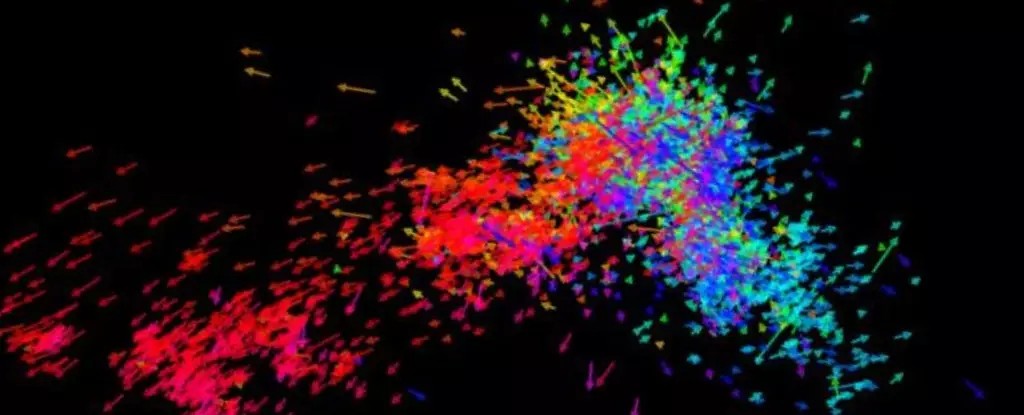In the vast expanse of the universe, the Small Magellanic Cloud (SMC) and its larger counterpart, the Large Magellanic Cloud (LMC), orbit our Milky Way galaxy like beautiful dancers in a cosmic ballet. Situated roughly 160,000 and 200,000 light-years away, these dwarf galaxies captivate both amateur stargazers and seasoned astronomers alike. Named after explorer Ferdinand Magellan, who first cataloged them in the 16th century, these clouds not only hold a rich reservoir of gas and young stars but also play a critical role in advancing our understanding of galactic interactions. Recent findings from researchers at Nagoya University have illuminated the precarious fate of the SMC, unveiling a potential unraveling caused by the immense gravitational pull of the LMC. This revelation could forever alter our insights into cosmic evolution and the forces governing galaxy formation.
The Evidence of Disruption
Leading this groundbreaking research, astronomers Satoya Nakano and Kengo Tachihara have uncovered startling patterns in the stellar movements across the SMC. Observing approximately 7,000 massive stars—each at least eight times the mass of our Sun—these researchers noted anomalies that suggest the SMC is not merely a passive entity in orbit but rather a galaxy undergoing dramatic transformation. The data reveals that some stars are moving toward the LMC while others are receding, hinting at the SMC being gradually torn apart by its larger companion. This gravitational tug-of-war gives compelling evidence of an ongoing galactic disruption potentially paving the way for the SMC’s eventual destruction.
Contrasting these findings with our own Milky Way raises intriguing questions. Galaxies typically exhibit a harmonic rotational movement among their stars and gas; however, the SMC defies this norm. The research indicates a striking absence of rotational motion among its massive stars, posing a challenge to existing models that outline how stars form and evolve within galaxies. Unlike the Milky Way, where stars operate in concert with their natal gas clouds, the stars of the SMC seem disconnected from the gas, which does not exhibit any detectable rotation. Such insights may prompt astronomers to recalibrate their understanding of the SMC’s mass and its gravitational interactions with neighboring galaxies.
Rethinking Galactic Evolution
This intriguing mismatch of motion suggests that the dynamics governing the SMC may differ significantly from those observed in spiraled, rotationally stabilized galaxies like our Milky Way. Understanding the nature of these differences becomes vital, especially as the SMC resembles some of the earliest galaxies formed in the universe. The new data related to star formation patterns in the SMC and their unique evolutionary trajectories might redefine our theories surrounding cosmic formation.
The implications of Nakano and Tachihara’s research extend far beyond just the SMC; they beckon a reevaluation of the complex gravitational relationship shared between the Magellanic Clouds and the Milky Way. The connection through the Magellanic Bridge, a stream of gas linking the two clouds, reframes our conceptual landscape of how galaxies pull on one another and evolve under mutual influence. Long-held beliefs in the stability of interactions among dwarf galaxies must contend with this emerging picture of gravitational violence.
Expanding Our Cosmic Horizon
This study not only illustrates the energetic turmoil experienced by the SMC but also deepens our comprehension of star formation in different environments. It emphasizes the importance of examining various galaxy types, especially irregular dwarf galaxies, to unlock secrets about the universe’s formative stages. The SMC, with its intriguing characteristics, presents a rare opportunity to scrutinize the mechanisms that shaped early cosmic history.
As we gaze at the night sky, the observable universe is a tapestry of events woven together by gravitational forces and cosmic interactions. Research like that conducted by the team at Nagoya University illuminates the intricate dynamics at play. The ongoing saga of the Small Magellanic Cloud serves as an alert for astronomers—reminding us that our galactic neighborhood is ever-changing, filled with stories that await discovery and reinterpretation. The cosmos remains a theatre of painted forces, ever urging the scholars of our time to look deeper and think critically about the universe’s elegant yet tumultuous design.


Leave a Reply